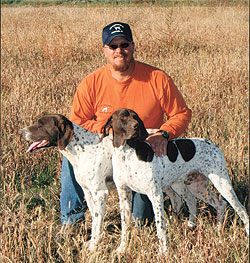By James B. Spencer
 Melvin Crow |
"Ideally," Melvin said, "you should introduce a pup to a wing or dead bird at about seven or eight weeks, provided the pup is socialized, happy, and bold, not shy. If a client brings me a pup that isn't socialized, I delay the bird introduction until I've had plenty of time to play with him. When we have a litter here, I introduce each puppy to a wing or dead bird before any of them goes to a new home."
To do this, Melvin gets down on the ground with the puppy in a confined area and teases the youngster with a wing or dead quail. When the pup becomes excited about the bird, Melvin tosses it a few feet. The pup runs after it and snatches it up. Then Melvin claps his hands to get the pup to return to him. Of course, in a confined area, he really has no place else to go.
"This is also a great way to start a pup retrieving," he said.If the pup is too rough with the dead quail, Melvin switches to a frozen quail. After the pup is comfortable retrieving a quail (frozen or unfrozen), he starts using a dead chukar to get the pup used to the larger bird.
Next, he introduces the wing-on-a-string technique to arouse the puppy's pointing instinct. When the pup is pointing the wing properly, has completed his obedience and whoa training, and is quite comfortable in cover, Melvin starts using planted birds out into the field to lead the youngster from sight-pointing to scent-pointing.
He starts out using quail, which he dizzies before he plants them. Later, he also uses dizzied chukar. Still later, he uses pheasants, but instead of dizzying these birds, he tucks their head under one wing and lays them down on that wing.
| Introducing Your Puppy To Birds | 

Don't miss out on tips for your retriever here. or your spaniel here.
|
|
"Many people use a checkcord," he said, "to prevent the pup from diving in on a planted bird. I don't. I simply stay close to the pup as he approaches the bird, control him with the whoa command, and if necessary grasp his collar to hold him in place."
He works the dog on only one or two birds per training session. He said that too many birds per session can over-excite the dog, causing him to start making mistakes, like flushing instead of pointing.
"By the way, and perhaps surprisingly," Melvin added, "I use the wing-on-a-string technique throughout the dog's training. My older dogs know it's just a game and they love to play it. What's more, I've found it a very positive way to introduce certain concepts, not only pointing, but also steadying to flush and even honoring."
In steadying and honoring, he uses the wing-on-a-string to teach the dog his new "job requirements." Then, he uses standard techniques for reinforcing those requirements.
When asked about common mistakes beginners tend to make in introducing their puppies to birds, Melvin said that rushing through training too quickly is the most common one."Everyone has hopes of a great field dog," he said. "If you train your dog correctly, you'll probably end up with one. However, many beginners rush their puppies from one training step to another before their dogs are ready. Some use training standards for older dogs, standards a puppy can't measure up to."
As a final thought, Melvin added, "Have patience and reasonable expectations. Remember that the more time you spend with your puppy, the better he will turn out to be. Be his leader and he will strive to please you every day."






